Storing kitchen knives properly is essential for maintaining their sharpness and ensuring safety in the kitchen. With a variety of storage options available, it’s important to choose a method that suits your space and cooking habits. From magnetic strips to knife blocks and drawer inserts, each solution offers its own benefits. Ensuring your knives are stored correctly can extend their lifespan, keep them at peak performance, and help prevent accidents. This guide will explore the best practices for how to store kitchen knives, helping you to select the right storage solution for your needs.
Why Store Kitchen Knives?
Store kitchen knives correctly is not just about organization; it’s a crucial step in maintaining the integrity and sharpness of the blades. Knives that are carelessly tossed into drawers can become dull quickly as they rub against other utensils. Moreover, improper storage can lead to dangerous accidents when reaching for a knife. By using designated storage solutions, you protect the blades from damage and ensure the safety of everyone in the kitchen . Proper storage methods, such as knife blocks, magnetic strips, or drawer inserts, keep knive securely in place and within easy reach. This approach not only extends the life of your knives but also enhances your cooking experience by keeping your tools in prime condition.
How Often Should I Clean My Knife Block?
Regarding the maintenance of your knife storage, cleaning your knife block is a task that often goes overlooked, yet it’s vital for hygiene and the longevity of your knives. Over time, knife blocks can accumulate crumbs, dust, and even bacteria in the slots where the knive are stored. This involves removing all knives, thoroughly vacuuming the slots to remove debris, and then washing the block with a mild detergent and warm water. For a deeper clean, consider using a small brush or pipe cleaner to get into the slots. After washing, let the block dry completely, preferably in a well-ventilated area. In direct sunlight, to prevent moisture from being trapped inside, which could potentially harm your knives or encourage bacterial growth. Regular cleaning not only maintains the aesthetic appeal of your knife block but also contributes to a safer and more hygienic Sharpen Kitchen Knives.
Importance Of Proper Knife Storage
Proper knife storage plays a critical role in the kitchen, impacting both the longevity of your knives and the safety of those who use them. Storing knives properly ensures that they retain their sharpness for longer periods, preventing the blades from becoming dull prematurely. Dull knives are not just inefficient; they can be more dangerous. As they require more force to cut through food, increasing the risk of slipping and causing injury. Additionally, proper storage solutions help to organize your kitchen space, making knive easily accessible while cooking and reducing clutter. This organization is essential in a busy kitchen environment, where efficiency and safety are paramount.
Magnetic Knife Strips
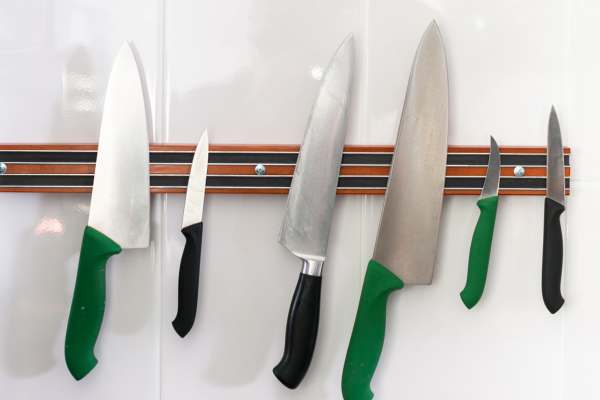
Knives are displayed openly, making it easy to select the right tool for the task at hand. Furthermore, magnetic strips minimize contact with surfaces that could potentially dull the blades, unlike some traditional knife blocks where sliding knives in and out of slots can wear down the edge over time. It’s important to choose a magnetic strip with a strong enough magnet to securely hold the knive in place. Yet not so strong that it poses a risk when removing them. Additionally, installing the strip out of the reach of children and away from high-traffic areas in the kitchen can enhance safety. Magnetic knife strips not only provide a practical storage solution but also add a touch of modern design to your kitchen.
Knife Blocks
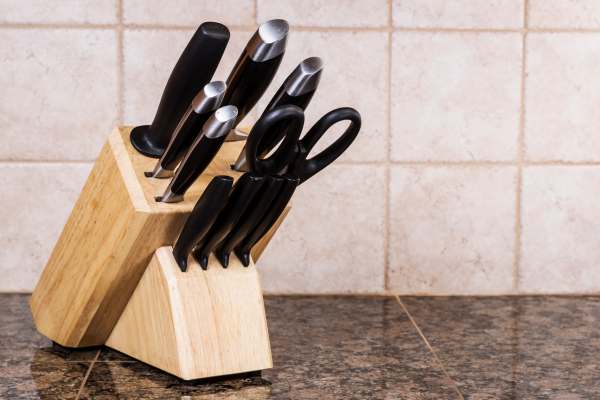
Knife blocks are a traditional and widely used storage method that offers both functionality and aesthetic appeal. Typically made from wood, bamboo, or plastic, these blocks feature. A series of slots to accommodate various types of knives, from chef’s knive to paring knives and sometimes even kitchen scissors or sharpening rods. One significant advantage of using a knife block is the protection it offers to the blades. By housing each knife in its own slot, the block prevents the knives from knocking into each other, thus maintaining their sharpness and preventing damage. Furthermore, knife blocks can contribute to kitchen decor, offering a range of styles and finishes that complement different interior designs.
Drawer Knife Trays
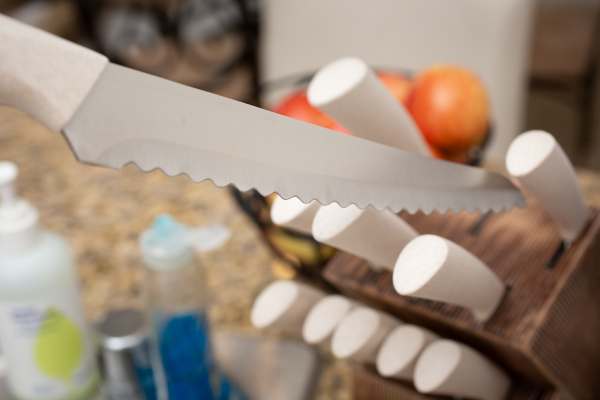
Drawer knife trays, on the other hand, provide an excellent storage solution. For those looking to save counter space or who prefer to keep knive out of sight for safety reasons or aesthetic preferences. These trays are designed to fit inside kitchen drawers, offering designated slots or grooves for knives to rest securely. This method not only protects the blades from damage but also minimizes the risk of accidental cuts when reaching into drawers. Drawer knife trays come in various materials, including wood, plastic, and metal, allowing for easy integration into any kitchen style. They also vary in size and capacity, accommodating small to extensive collections of knive. A key consideration when using drawer knife trays is to ensure that. The drawer is organized and that the tray fits snugly to prevent the knives from moving around when the drawer is opened or closed.
Under-Cabinet Storage
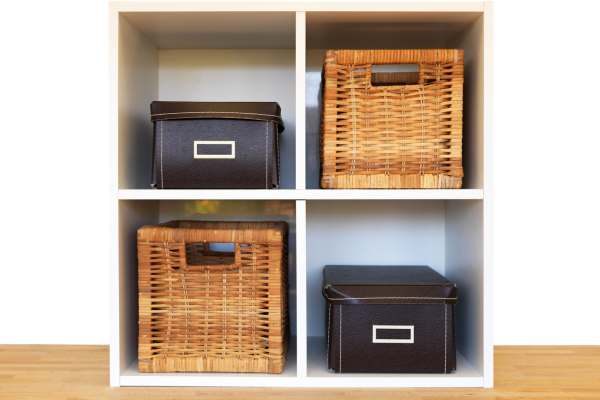
Under-cabinet storage solutions offer an innovative and space-saving way to store kitchen knives, making them an excellent option for kitchens with limited counter space or for those seeking a clutter-free look. This method typically involves a pull-down or swing-out mechanism that can be tucked away under a cabinet when not in use, making knives easily accessible yet discreetly stored. These systems often feature magnetic strips or slots to securely hold knive in place, ensuring that blades are kept sharp and safe from potential damage. Under-cabinet storage not only helps to maximize the efficiency of kitchen space but also keeps knives out of the reach of children, providing an added layer of safety. Installation can vary from simple DIY solutions to more sophisticated systems requiring professional assistance, allowing for flexibility based on individual needs and kitchen configurations.
Caring for Your Knives
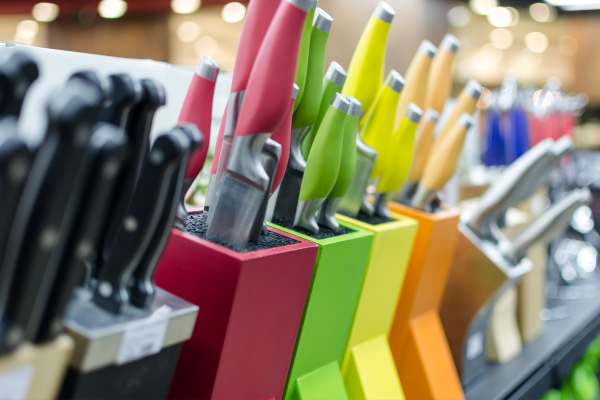
Proper care of kitchen knives extends beyond just safe store; maintaining their condition requires regular cleaning, sharpening, and handling practices. After each use, knives should be washed by hand with warm water and mild detergent, then dried immediately to prevent rust or corrosion—dishwashers, while convenient, can dull knife blades and damage handles. Sharpening your knives is also crucial; a honing rod can realign the blade’s edge between uses, while a sharpening stone or professional sharpening service can restore a knife’s sharpness when it becomes dull. Additionally, using the right knife for the task at hand can prevent unnecessary wear and tear—avoid using fine-edged blades on hard surfaces like bones or frozen foods. By adhering to these care practices, you can ensure your knive remain in top condition, enhancing your cooking experience and ensuring your investment lasts for years to come.
Creative Diy Solutions
1. Magnetic Knife Rack
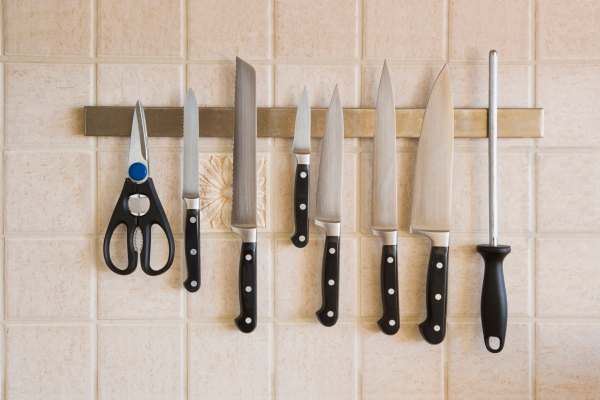
Instead of purchasing a commercial magnetic strip, create your own magnetic knife rack using a wooden bar and strong magnets. This project allows for customization in size and finish to match your kitchen’s decor. Attach the magnets securely within the wood and mount the rack on the wall. Under cabinets to save space while keeping your knives accessible and safely stored.
2. PVC Pipe Knife Holder
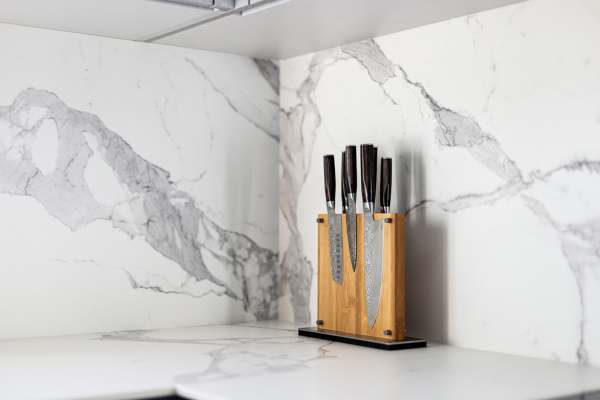
For an affordable and unique knife storage solution, consider using a piece of large PVC pipe. Cut the pipe to a desired length, sand the edges smooth, and fill it with bamboo skewers or plastic straws. This setup allows you to insert knives of any size securely, and the holder can be placed in a drawer or on the counter. The skewers or straws hold the knives upright without dulling the blades. And the PVC pipe can be painted or decorated to suit your style.
3. Repurposed Block Knife Holder
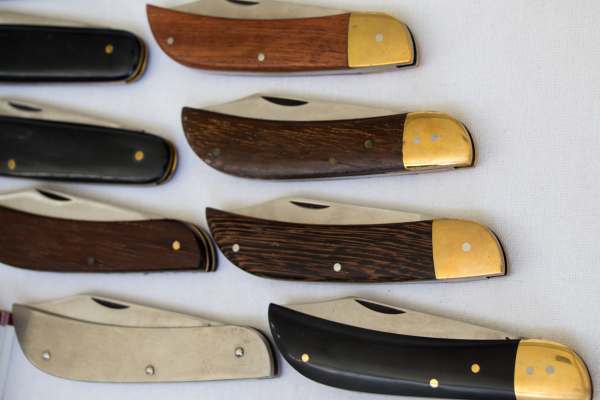
Transform an old book, a block of wood, or even a dense bundle of dried reeds into a knife holder by creating slits or spaces to insert the knives. This method is particularly useful for those who appreciate rustic or eclectic aesthetics. Ensure the material is stable and durable enough to securely hold the knive.
4. Under-Shelf Jar Hangers
For smaller knives or frequently used utensils, attach the lids of jars under a shelf or cabinet. Screw the lid in place, and then twist the jar on and off to store or retrieve items. This clever solution keeps countertops clear and can be a decorative way to display kitchen tools.
Maximizing Small Spaces
In small kitchens, every inch of space counts. Utilizing vertical space and hidden storage opportunities can transform a cramped kitchen into an organized and functional area. Here are some tips:
- Install Shelves Above Windows or Doors: Use these often-overlooked spaces for storing less frequently used items or decorative pieces.
- Use the Sides of Cabinets: Attach racks, hooks, or magnetic strips to the sides of cabinets for additional storage.
- Drawer Organizers: Customizable drawer inserts can help maximize space and keep utensils and knives neatly organized.
- Hanging Baskets or Racks: Use the ceiling or open wall space to hang pots, pans, or utensils, freeing up cabinet and counter space.
Are Drawer Trays Suitable For All Types Of Knives?
Drawer trays are a practical and organized store solution for kitchen knives, designed to accommodate a wide range of knife types and sizes. Their suitability for all knive can vary based on the design of the tray and the specific dimensions and shapes of the knive. It’s important to consider the size and depth of your drawers, as well as the construction material of the tray. To ensure that it provides a secure and protective environment for your entire knife collection. Therefore, while drawer trays are versatile, assessing their compatibility with your knives before integration into your kitchen setup is crucial.
Conclusion
The method you choose for storing kitchen knive significantly influences their longevity, sharpness, and safety. Options like knife blocks, magnetic strips, under-cabinet systems. And drawer trays each offer unique advantages tailored to different kitchen layouts and personal preferences. While magnetic strips and under-cabinet solutions save counter space and keep knives out of reach of children, knife blocks and drawer trays provide traditional and hidden storage methods, respectively. Ultimately, investing time in choosing and maintaining the right storage method pays off by safeguarding your kitchen tools. And making your culinary endeavors both safer and more enjoyable.
